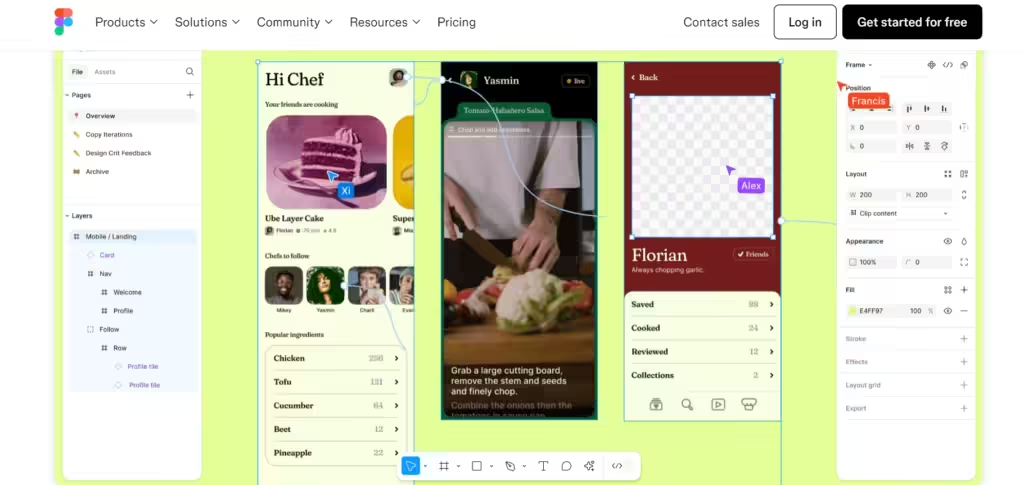Top 10 AI tools for UI/UX design

Are you an author spending endless hours working YEARS on just your UI/UX interfaces to only feel like it is the very surface of whats possible? As we move into the fast-paced world of digital today, being ahead in the game is key. But what if you could supercharge your design process and instead of hours, deliver a polished UI in 1hour or less with out carefully curated list of top AI tools for UI/UX design.
Welcome to AI tools for your UI/UX design . Over the past several decades, these game-changing creations have completely altered designers processes and concepts, enabling record-breaking levels of productivity combined with extensive creativity. AI is changing the UI/UX design world from better collaboration to producing color palettes and even delivering more refined designs of sketch! In this blog post, we delve to the top 10 AI tools that are ruling over design and can be useful for you as well while being one step ahead of your competitors. 🚀
Find out how AI can revolutionize your design workflow here They cover the gamut of AI tools for UI/UX design from high-level theory to powerhouse platforms such as Figma and Adobe Sensei, etc. so let’s get started with our hand-selected list!

Table of Contents
- Understanding AI in UI/UX Design
- Figma + AI: Streamlining Collaborative Design
- Adobe Sensei: Intelligent Design Assistant
- Sketch + AI: Enhancing Vector Design
- UXPin Merge: Bridging Design and Development
- Uizard: Transforming Sketches into Designs
- Remove.bg: Effortless Background Removal
- Khroma: AI Color Palette Generator
- Artbreeder: AI-Assisted Image Generation
- Brandmark: AI Logo Design Assistant
Here is the comprehensive table of contents that delineates all major AI tools for your UI/UX design. This guide will cover a variety of AI-enabled solutions that can help you ensure optimal design workflows and efficiency, ranging from collaborative design platforms to intelligent assistants and specialized tools for different aspects of design.
| Tool Category | Examples |
|---|---|
| Design Platforms | Figma, Sketch |
| Design Assistants | Adobe Sensei |
| Prototyping | UXPin Merge |
| Sketch-to-Design | Uizard |
| Image Editing | Remove.bg |
| Color Selection | Khroma |
| Image Generation | Artbreeder |
| Logo Design | Brandmark |
In the next part, we take a closer look at each of these AI tools to show you how AI is changing different parts of UI/UX design: from cooperation in teamwork and automating repetitive tasks or even coming up with creative ideas.

Understanding the role of AI tools in UI/UX Design
A. Definition of AI in design context
The use of machine learning algorithms with smart systems in the UI/UX design is commonly known as Artificial Intelligence (AI) powered Ui UX. By automating data analysis, pattern recognition, and predictive modeling for designers; these AI tools help design your UI/UX enabling us to build more efficient, user-friendly as well as aesthetically great interfaces
B. Current trends in AI-powered design
The field of AI-powered design is rapidly evolving, with several exciting trends emerging:
- Automated layout generation
- Personalized user experiences
- Predictive design suggestions
- Natural language processing for content creation
- Intelligent image and video manipulation
| Trend | Description | Impact |
|---|---|---|
| Automated layout generation | AI algorithms create responsive layouts based on content and design principles | Speeds up the design process and ensures consistency |
| Personalized user experiences | AI analyzes user behavior to tailor interfaces for individual preferences | Improves user engagement and satisfaction |
| Predictive design suggestions | AI offers design recommendations based on current trends and user data | Enhances creativity and keeps designs relevant |
C. Benefits of AI tools for UI/UX designers
AI tools offer numerous advantages to UI/UX designers, revolutionizing their workflow and output:
- Increased productivity: AI automates repetitive tasks, allowing designers to focus on creative aspects.
- Enhanced creativity: AI-generated suggestions inspire new ideas and push creative boundaries.
- Data-driven decision-making: AI analyzes user data to inform design choices, resulting in more effective interfaces.
- Improved accessibility: AI tools help create more inclusive designs by considering diverse user needs.
- Faster prototyping: AI-powered prototyping tools enable rapid iteration and testing of design concepts.
When designers utilize these AI tools, they can build more innovative and user-friendly interfaces while speeding up their design process. Even more importantly as AI continues to improve, its ambitions and purpose in UI/UX design are going so far that it can bring about many new outcomes in the digital atmosphere.
1. Figma + AI: Streamlining Collaborative Design

The popular collaborative design tool Figma has incorporated AI to improve its features and make the process of designing simpler. In this article, we will delve into how AI in Figma is transforming the workflows of a UI/UX designer.
Smart Component Recommendations
Figma provides smart component recommendations based on your use of AI relieving you from having to guess what a consistent design might look like. It examines the existing components you have and provides suitable suggestions based on what context your design is in right now. This is not just a time-saver but it helps in maintaining the overall design coherence of projects.
- Contextual suggestions
- Improved design consistency
- Faster component selection
Automated Layout Suggestions
Figma’s AI-powered auto layout recommendations make it easier to create responsive and visually appealing designs for your app It provides smart suggestions for element placement and spacing based on examples it has learned from other designs.
| Feature | Benefit |
|---|---|
| Responsive layouts | Adapts to various screen sizes |
| Intelligent spacing | Ensures visual harmony |
| Time-saving | Reduces manual adjustments |
AI-Enhanced Prototyping Features
Design reactions to the next level with Figmas AI-powered prototyping features. This makes the prototyping process extremely intuitive and it will help guide you to make selective decisions by predicting your most possible user flows & interactions.
- Smart transitions
- Gesture recognition
- Automated animation suggestions
The AI-powered features in Figma not only accelerate work but also unleash creativity by enabling designers to focus on more high-level design decisions.
2. Adobe Sensei: Intelligent Design Assistant

Adobe Sensei (the AI and machine learning technology that powers Adobe’s Creative Cloud) has changed how designers approach their work forever. The design assistant is intelligent and offers a suite of powerful features to choose from that prepare students, professionals, designers, or hobbyists for whatever their work needs.
Smart Object Selection
The smart object selection tool Adobe Sensei, is a game changer for UI/UX designers as an AI-based tool, it can quickly and accurately recognize the various complicated objects in images to make selection easy. Features → When this will come to the fore!!
- Isolating UI elements for reuse
- Extracting assets from mockups
- Creating complex masks for intricate designs
Color Matching and Palette Generation
Sensei’s color capabilities go beyond basic matching:
| Feature | Benefit |
|---|---|
| Intelligent color matching | Ensures consistency across designs |
| AI-powered palette generation | Creates harmonious color schemes |
| Color trend analysis | Keeps designs current and appealing |
Auto-Reframe for Video Content
Sensei Auto-Reframe is great for UI/UX designers responsible for video content with the recent importance of responsive design:
- Automatically adjusts video framing for different aspect ratios
- Maintains focus on key elements across devices
- Saves time in creating multi-platform video content
Content-Aware Fill and Crop
Sensei’s content-aware technologies enhance the design process:
- Fill: Seamlessly removes unwanted elements from images
- Crop: Intelligently suggests optimal cropping based on content
Ultimately, these features enable designers to iterate over their visual assets in a very straightforward manner with confidence and thus ensuring that the final product is polished.
Adobe Sensei intelligent design assistant will save you hours of boring work and a lot more time to be creative with your UI/UX Design. As we dig deeper into the full library of AI tools, we will show how they complement and build upon these functionalities.
3. Sketch + AI: Enhancing Vector Design

Sketch, the well-known vector graphics editor, has decided to empower its design with AI. The workflow efficiency and design consistency both have improved a lot in the case of Sketch by the inclusion of smart features.
Intelligent Layer Naming
Organizing and naming layers is probably one of the most time-consuming tasks for designers. Sketch uses AI intelligence to automatically suggest a descriptive title for layers. This not only reduces time but also standardizes logic between projects and teammates.
| Benefits of Intelligent Layer Naming |
|---|
| Time-saving |
| Improved organization |
| Consistent naming conventions |
| Enhanced collaboration |
Automated Design System Creation
Create and maintain your design system using AI from Sketch The software studies those patterns and delivers a full cohesive design system:
- Color palettes
- Typography scales
- Component libraries
- Spacing rules
This automation speeds up the generation of design systems, taking care of the most detailed configurations so that designers can work on slight improvements and modifications from those automized elements.
AI-Powered Symbol Organization
Sketch’s AI algorithms help designers organize and manage symbols more efficiently. The software:
- Analyzes symbol usage patterns
- Suggests optimal grouping structures
- Identifies redundant or similar symbols
- Recommends symbol consolidation
It is an ingenious way of organization and makes the design cleaner, and faster file performance.
With AI-based vector design, Sketch makes it easy to expedite repetitive tasks and keep projects consistent. These AI-augmented features save time and also result in a more uniform design that looks professional. In my following writings, we are going to pick up the pace by looking at how AI is being embedded in other tools and transforming different areas of UI/UX design.
4. UXPin Merge: Bridging Design and Development

UxPin Merge is a powerful program that will help close the gap between design and development worlds while being an unused asset by UI/UX professionals throughout their daily work. UXPin Merge comes equipped with AI technology that allows for things like design process automation and fostering closer collaboration between designers and developers.
Smart Component Suggestions
The AI-powered smart component suggestions in UXPin Merge are a game-changer for designers. It also examines your design patterns take and what type of components best fits in to both style and functionality for project. It does save you time and maintains a consistent approach throughout your designs.
- Automatically identifies recurring design elements
- Suggests appropriate components based on context
- Learns from your design choices to improve future suggestions
Automated Accessibility Testing
A key feature of UXPin Merge is its native automated accessibility evaluation. This AI-powered tool check your designs and point out accessibilty issues to help you design more inclusive experiences.
| Accessibility Feature | Description |
|---|---|
| Color contrast analysis | Verifies that all interactive elements are accessible via the keyboard |
| Screen reader compatibility | Ensures all elements are properly labeled for screen readers |
| Keyboard navigation testing | Verifies that all interactive elements are accessible via keyboard |
AI-Driven Code-to-Design Conversion
The end-to-end AI capability of code to design conversion allows Translate Design time-consuming into engaging elements using our UXPin Merge. This novel feature allows developers to enter code snippets and the AI will understand it, translating this into a design component with plaintext.
- Supports multiple front-end frameworks (React, Angular, Vue.js)
- Maintains fidelity between code and design
- Enables real-time collaboration between designers and developers
With these AI-powered features, UXPin Merge bridges the distance further between design and development for even more streamlined workflows that result in better end products. We will check out how AI is being a game changer on image manipulation in UI/UX design with things like Remove. bg.
5. Uizard: Transforming Sketches into Designs

Uizard is reimagining the UI/UX design workflow by using AI to convert simple pencil doodles into polished digital designs. It helps to get clients increased productivity, and better process quality and it will be quick to implement on design work so the tool is ideal for any designer workflow making it a popular choice among all of them.
Automated Wireframe Generation
Think of Uizard as an AI assistant that specializes in transforming messy sketches into elegant, professional wireframes. Just save your hand-drawn ideas, and the tool will interpret them to give you organised layouts & components. This feature cuts down on the hours upfront and enables a designer to preserve their conceptual in-line process adopted for refining.
| Feature | Benefit |
|---|---|
| Sketch interpretation | Rapid conversion of ideas to digital format |
| Component recognition | Automatic identification of common UI elements |
| Layout structuring | Consistent and organized wireframe output |
Design Pattern Recommendations
Uizard also has the possibility of suggesting design patterns based on how you draw what would be your paper prototyping. Based on your input, the AI then provides you with specific layout options and suggests whole page navigational patterns along with interactive styles that are aligned to modern UI/UX design trends.
- Contextual suggestions for improving user flow
- Accessibility-focused recommendations
- Industry-specific design pattern proposals
Instant Design System Creation
Uizard makes designing design systems seamless and easy. Designs: While you craft your designs, the AI inherently creates a complete design system with :
- Color palettes
- Typography hierarchies
- Component libraries
- Spacing and grid systems
This feature helps achieve design consistency throughout the products and gives a pre-built system that can be used out of box to increase speed in development.
AI-Powered Sketch Recognition
The solution’s capabilities are made possible with its powerful sketch-recognition technology. Even the most rudimentary of sketches can be accurately (within a few degrees) interpreted and broken down by this AI-driven feature in terms of boilerplate design elements such as:
- Buttons and form elements
- Navigation menus and bars
- Images and placeholder content
- Text areas and headings
Uizard helps designers quickly get from concept to a live design and learn, through accurately identifying these elements — cutting down the lead time for initial designing of UX/UI.
6. Remove.bg: Effortless Background Removal

The functionality that the software tools bring to designers is unparalleled; one of my favorites would have to be this Background remover (bg). It provides three core elements that make it a necessary part of every designer’s toolbox:
A. One-click background elimination
Remove.bg’s most impressive feature is its ability to remove backgrounds with just a single click. This AI-powered tool can:
- Accurately detect and isolate the main subject
- Remove complex backgrounds, including gradients and patterns
- Preserve fine details like hair and fur edges
B. Batch processing capabilities
For designers working with multiple images, Remove.bg offers efficient batch processing:
| Feature | Benefit |
|---|---|
| Bulk upload | Save time by processing multiple images at once |
| Consistent results | Ensure uniform background removal across all images |
| Customizable settings | Apply the same parameters to all images in a batch |
C. Integration with design software
Remove.bg seamlessly integrates with popular design tools, enhancing workflow efficiency:
- Photoshop plugin for direct access within the software
- Figma integration for real-time background removal
- API access for custom integrations with other design platforms
By leveraging Remove. bg’s AI-powered background removal whilst designing, UI/UX designers can reduce the time it which takes to edit going through version after version by concentrating more on design creativity. In other posts we will explore more AI tools in design and how they work together to give a full rounded view of an AI assisted workflow 🙂
7. Khroma: AI Color Palette Generator

Khroma — the Color Tool That Never Fails You (AI-powered color palette generator for designers) It is a user-friendly tool that used machine learning algorithms to craft distinct color pallets as per your preferences, thus every palette would be customized according to your taste and project needs.
Export options for design software
It integrates with your design software of choice for easy integration in generating colors palettes you actually use. Following are a couple of the available export features in this tool.
- HEX codes
- RGB values
- CMYK values
- Adobe Swatch Exchange (ASE) files
This adaptability lets designers to directly pass these color schemes in their usual disign software be it Adobe Creative Suite, Sketch or Figma.
| Export Format | Compatibility |
|---|---|
| HEX | Web design, CSS |
| RGB | Digital design, screens |
| CMYK | Print design |
| ASE | Adobe Creative Suite |
Personalized color suggestions
A major selling point of Khroma is it’s designed to personalize color suggestions based on your own learning preferences. Here’s how it works:
- Initial survey: Users complete a brief color preference survey
- AI analysis: The tool analyzes your choices using machine learning
- Custom algorithms: Khroma creates algorithms tailored to your taste
- Continuous learning: The AI refines suggestions based on your interactions
With this level of detail, the color palettes are derived not only so that they look nice but also while considering what you want your design to feel like and adhering to brand guidelines.
Accessible color combinations
Khroma takes accessibility seriously, offering features that help designers create inclusive color schemes:
- Contrast analysis: Automatically checks color combinations for WCAG compliance
- Alternative suggestions: Provides accessible alternatives for non-compliant color pairs
- Simulation tools: Allows designers to preview their palettes under different types of color blindness
Khroma makes your designs look great, but the primary reason behind our decisions is improving accessibility — we want to make sure any user has a delightful experience when using an interface designed with Khroma.
Having finished with the AI-based color palette generator of Khroma, next let’s take a look at another amazing AI tool which is reshaping image creation in UI/UX design.
8. Artbreeder: AI-Assisted Image Generation

Artbreeder is a powerful AI tool that revolutionizes the way UI/UX designers create and manipulate visual assets. This innovative platform harnesses the power of artificial intelligence to generate unique images, blend existing ones, and apply style transfers, offering designers a wealth of creative possibilities.
Creating unique visual assets
Artbreeder’s AI algorithms allow designers to generate completely original images from scratch. By inputting specific parameters or starting with a base image, designers can:
- Produce diverse character designs for user personas
- Create abstract backgrounds for app interfaces
- Generate unique icons and symbols for UI elements
Blending multiple images
Artbreeder makes the blending of many images into one a cynch, leading to fresh compositions without missing a beat. Some advantages this capability provides to UI/UX designers are as follows
| Advantage | Description |
|---|---|
| Inspiration | Combine elements from different designs to spark new ideas |
| Consistency | Merge brand elements with stock images for a cohesive look |
| Customization | Tailor existing assets to fit specific project requirements |
Style transfer capabilities
This means artists can use Artbreeder to artificially transfers the aesthetic of one image onto another. It may change entire UI/UX design:
- Apply a consistent aesthetic across various design elements
- Experiment with different visual styles quickly and efficiently
- Create unique textures and patterns for backgrounds or UI components
The guidance and the solution for how UI/UX can attain brilliant designs, save time along with generating beautiful visual graphics by harnessing its AI-powered image creation ability through Artbreeder could be found in this article.
9. Brandmark: AI Logo Design Assistant

Brandmark is a game-changing AI logo generator for UI/UX designers. When it comes to logo design, Brandmark is a feature-rich artificial intelligence application that has just about everything you need to quickly create beautiful and creative logos.
Generation of logos based on the brand’s identity
Brandmark uses an AI algorithm to understand your brand and creates multiple logo designs based on it. Just enter your brand name, industry, and key attributes — an AI will put together a range of logo designs that reflect everything you are all about.
Color scheme suggestions
Brandmark can generate colour palettes to match your brand style, which I also think is awesome! For a more tailored solution, the recommend palettes we provide are designed to comprise colours that should be evoked by targeted emotional responses based on colour psychology and industry trends.
| Color Scheme Type | Benefits |
|---|---|
| Monochromatic | Elegant and cohesive look |
| Complementary | Eye-catching contrast |
| Analogous | Harmonious and soothing |
| Triadic | Vibrant and balanced |
Font pairing recommendations
A logo without the right typography is incomplete and Brandmark’s AI works on this as its strength. By recommending font pairings that compliment visual elements from your logo (colors), and enhance readability across various applications.
- Sans-serif fonts for modern and clean looks
- Serif fonts for traditional and sophisticated brands
- Display fonts for unique and memorable logos
- Handwritten fonts for personal and artistic touches
Mockup generation for brand visualization
To help you visualize how your logo will look in real-world applications, Brandmark offers AI-powered mockup generation. This feature allows you to see your logo on:
- Business cards
- Social media profiles
- Website headers
- Product packaging
- Signage and billboards
Their aim was to make sure that designers made the right choice when choosing their logo and allow brands to be consistent in form across different mediums.
BrandmarkWith its AI technology, Brandmark simplifies the design process and has graphic designers making professional-looking logos in minutes. In more upcoming articles, we are going to see how artificial intelligence is contributing to changing the face of many elements which will make our UI/UX design easier so be prepared for a new era where Designing would not be possible manually.

Conclusion
The incorporation of AI tools in UI/UX design is redefining the face of this domain by providing infinite resources to bring fluidity and spark into designers’ works. These tools like Figma’s collaborative AI to the intelligent assistance provided by Adobe Sensei are changing how designers work for good. New vector and prototyping tools like Sketch, UXPin Merge, Visual Inspector, or Uizard are expanding the horizon for creating with vectors. So products like bg, Khroma, Artbreeder, and Brandmark are making image editing or color selection much easier than it used to be.
We may say that AI is an indispensable activity when we turn our eyes over towards the coming trends of UI/UX designs. Practice these tools and be the one leading your design innovations, generating higher output levels within an unusually small time frame. No matter if you are an experienced UI/UX designer or a beginner in the field, testing these AI-owned tools for creating high-grade design work would take your design process to another level. Be curious, remain experimenting, and see AI changing the UI/UX design across the entire world.


